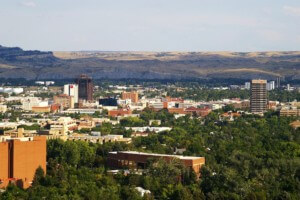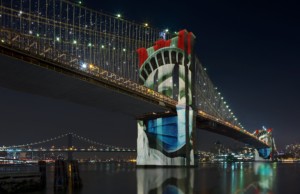[ Editor’s Note: Peter Murray, of the New London Architecture center, together with a dozen architects and planners, is biking from Portland, Oregon to Portland Place in London, studying how cities are responding to the demand for better cycling infrastructure. He reports from the start of his ride. The Architect’s Newspaper is USA media sponsor of the trip and will post periodic updates of these architects on bicycles. ]
Cycling through the small towns of Idaho and Montana provides useful lessons for the English visitor about the growth of settlements in the US and allows interesting comparisons with the development of urban structure in Britain.
While we in the UK have high streets, they are a very different sort of place to main streets. English settlements often developed around market squares, their structure defined by the relationship between the church and the ‘big house’ occupied by the feudal landlord as well as topographical features and land ownership.
The main streets of places we have cycled through in the last couple of weeks clearly grew up initially to service the needs of the traveller and retained their preeminence in the urban fabric because of the ubiquitous grid plan—a form promoted by Penn because he beleived it would prevent the outbreaks of fire and disease that bedevilled European cities in the 16th and 17th centuries.
So as we followed the Lewis and Clark trail we came to towns like Kamiah, once the winter home of the Native-American tribe Nez Perce and now a tourist center with a main street remodelled along Western/Victorian theme. The wide main street is the heart of the place lined with two-story buildings with cut-out profiles that, to the tourist look as though they should be fronted with a board walk and somewhere to hitch your horse.
We visited Bozeman, Montana. A look at the map confirms Main Street’s preeminence among city’s streets. We had been told of Bozeman’s hippy/liberal tendencies, largely on the basis that it is a university town. However the impression from Main Street was that this was a well-to-do town with its buildings in good repair, its shops and restaurants prosperous and an almost European intensity of street use with cyclists, pedestrians and cafe tables on the sidewalk. One American architect in the party—now working in London—described the look of Bozeman as “art directed” with its neat brickwork, refurbished buildings and tasteful color palette.
The following day we cycled up Main Street in Reed Point—the home of the Great Montana Sheep Drive, past a tumble down bar that boasted “Indians and mountain men welcome here” and were accosted by a local who believed all cyclists to be dangerous lefties. Being British was even worse: “Why don’t you commies go to Iraq or Iran instead of coming here?” When it was suggested that the United Kingdom was not a communist state, the riposte was “No guns – no freedom!”
Nothing of the sort, of course, happened when we went through Missoula. Described by the locals as a “spot of blue in a sea of red,” it certainly had more of a hippy feel to it than Bozeman, less art directed, with buskers on the streets and offers of grass outside bars in the evening. Most importantly for us it is the headquarters of the Adventure Cycling Association who provide excellent information for long distance riders, particularly those going across the continent. The cycling provision in the center of town was fair enough, with bike lanes and a path along the Clark Fork River. However, in the outer areas the infrastructure for cyclists was non-existent with some of the most dangerous conditions we have yet encountered.










